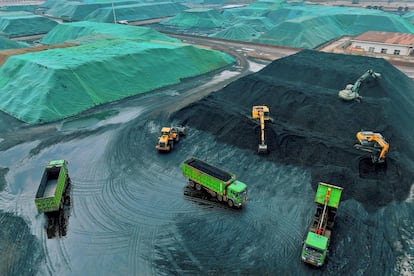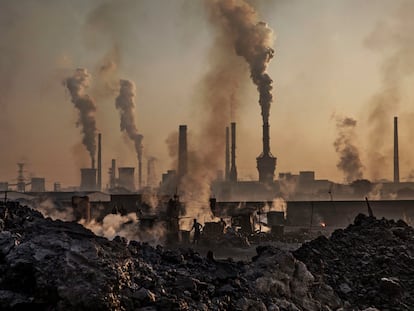The rise of renewable energy puts China on track to end its CO₂ emissions growth
The advance of solar and wind power has displaced coal as the world’s leading emitter of greenhouse gases


In the mid-2000s, China became the country that emits the most greenhouse gases into the atmosphere. Since then, the gap with the United States and the European Union — historically the main culprits behind global warming — has been widening, as the Asian giant grows economically. As of 2024, China is currently responsible for around 30% of all global emissions.
The commitment that this world power has made within the Paris Agreement to combat climate change is that, by 2030, its annual emissions of carbon dioxide (CO₂) — the main gas that overheats the planet — will reach a ceiling. But several groups of international analysts point to the possibility that this peak has already been reached thanks, mainly, to the massive rise of renewable energies in China.
“If current rapid wind and solar deployment continues, then China’s CO₂ output is likely to continue falling, making 2023 the peak year for the country’s emissions,” notes a recent article published by the British research center Carbon Brief.
“There’s a possibility that China has already passed its peak, but no one can be sure yet,” Dave Jones tells EL PAÍS. He’s a member of Ember, a think tank made up of experts who study energy and climate matters. “There are signs, but we have to wait four or five months to see if [China’s levels] continue to fall as [they have in] the last three months, to know if the peak has really been reached. I’m reasonably optimistic,” adds Rafael Salas, a professor of Economic Analysis at the Complutense University of Madrid.
Talking about greenhouse gases in China implies talking about coal and the country’s electricity sector. “Forty percent of all the country’s emissions come from the electricity sector… that’s a lot. In Spain, it’s between 10% and 15%,” Salas explains. That’s because power generation in the Asian giant has long been dominated by coal: last year, 60% of the country’s electricity came from burning the polluting fossil fuel. But in May, that share fell to a record low of 53%, according to data from Carbon Brief.
“Solar and wind are now meeting the bulk of China’s electricity demand growth,” Jones says. By May 2024, 12% of the country’s electricity came from solar — just a year ago it was 7% — 11% was generated by wind and 15% by hydro. The remaining 10% was shared by nuclear, gas and biomass.

But to get a full picture of what’s happening, we must look beyond the enormous advance of renewables. China is installing photovoltaic power at a dizzying speed. Pep Canadell — executive director of the Global Carbon Project, an international benchmark in monitoring global emissions — points to three components in the slowdown in emissions growth in this country. Firstly, the aforementioned reduction in the use of coal, linked to the rapid growth of wind and, above all, solar power. Secondly, the halt in the use of oil, linked to advances in the electrification of transport. And, thirdly, a decrease in the production of cement and steel, which is linked to the slowdown in the construction sector.
This last point is perhaps where there’s the most uncertainty. “China has consistently used the construction sector when it has needed to revive the economy in the face of a slowdown,” Canadell recalls. “We’ve seen it many times over the last 20 years… and it can happen again.” However, the director of the Global Carbon Project adds: “We know that, in the long-term, the great construction boom isn’t sustainable. As the service economy in China grows more, the role of construction — and its emissions — will decrease.”
Along the same lines, Jones affirms that the economy of the Asian country “is moving away from the construction of more infrastructure, after having built so many apartments, roads and railways in the last decades.”
“This means that the use of cement and steel is decreasing,” he adds.
In the third part of this story — transportation — there are fewer doubts if we look at the evolution of electric vehicle sales in China, as Salas points out. “In terms of transport electrification, China is one of the most advanced countries in the world. In June, 45% of passenger cars sold were electric or plug-in hybrids. By the end of the year, the forecast is that it will be 50%.”
Therefore, what happens in the electric sector is decisive in knowing whether the peak of emissions has truly been reached. This is only really possible to know when we gain further perspective… that is, time.
Latent risk
Canadell prefers to be cautious when it comes to certifying whether China has really reached that ceiling: “It’s not the first time that analysts have talked about the peak of emissions in China and then seen them grow again. We also talked about the peak of coal emissions for the first time in 2013, but it lasted very few years, and we saw growth again.”
This expert points out that there’s a latent risk: the industrial park of coal-fired plants that China has already built is currently underused, due to the boom in renewables. But if production is ever ramped up in the future, this could cause emissions to rise quickly again.
However, Canadell is clear that the growing power of renewables will increasingly push coal out of the Asian country’s electricity mix, as is happening in Europe: “There are structural changes that are occurring that will make the peak a reality. If not now, then soon.”
It’s not enough to stop growing
But it’s not enough to reach the maximum emissions level and stay there. Canadell believes that the most likely thing is that now, there will be several years of “small decreases and small increases.”
“This could easily last until the end of this decade, before we see a consistent decrease in emissions,” the expert clarifies. Scientists warn that what’s needed for global warming to stay within the less catastrophic limits is for global emissions to fall sharply during this decade.
The same analysis applies to the rest of the world, where peak emissions are also close to being reached. “If governments are able to meet their commitments to triple global renewable capacity and double energy efficiency improvements by 2030, we’ll be in a new era of declining CO₂ emissions,” Jones affirms. But that moment still hasn’t arrived. “This is because massive price drops have occurred so recently — especially for electric cars, solar panels and batteries — that governments haven’t yet come to terms with how quickly and cheaply these technologies can be rolled out,” the analyst from Ember concludes.
Sign up for our weekly newsletter to get more English-language news coverage from EL PAÍS USA Edition
Tu suscripción se está usando en otro dispositivo
¿Quieres añadir otro usuario a tu suscripción?
Si continúas leyendo en este dispositivo, no se podrá leer en el otro.
FlechaTu suscripción se está usando en otro dispositivo y solo puedes acceder a EL PAÍS desde un dispositivo a la vez.
Si quieres compartir tu cuenta, cambia tu suscripción a la modalidad Premium, así podrás añadir otro usuario. Cada uno accederá con su propia cuenta de email, lo que os permitirá personalizar vuestra experiencia en EL PAÍS.
¿Tienes una suscripción de empresa? Accede aquí para contratar más cuentas.
En el caso de no saber quién está usando tu cuenta, te recomendamos cambiar tu contraseña aquí.
Si decides continuar compartiendo tu cuenta, este mensaje se mostrará en tu dispositivo y en el de la otra persona que está usando tu cuenta de forma indefinida, afectando a tu experiencia de lectura. Puedes consultar aquí los términos y condiciones de la suscripción digital.
More information

The battle for lithium: US and China fight over Argentina’s white gold
Archived In
Últimas noticias
Most viewed
- Reinhard Genzel, Nobel laureate in physics: ‘One-minute videos will never give you the truth’
- Oona Chaplin: ‘I told James Cameron that I was living in a treehouse and starting a permaculture project with a friend’
- Pablo Escobar’s hippos: A serious environmental problem, 40 years on
- Chevy Chase, the beloved comedian who was a monster off camera: ‘Not everyone hated him, just the people who’ve worked with him’
- Why we lost the habit of sleeping in two segments and how that changed our sense of time









































